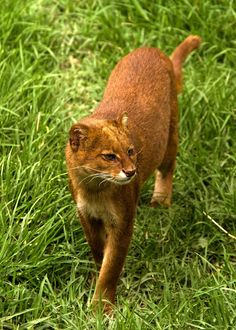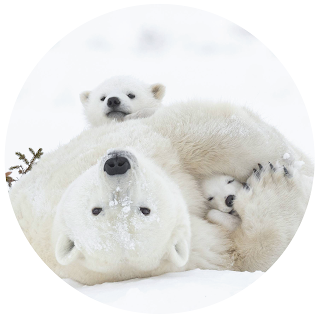Gulf Coast Jaguarundi
 |
| Source: http://ingrid.zcubes.com/zcommunity/v.aspx?mid=346686&title=gulf-coast-jaguarundi |
Gulf Coast Jaguarundi Recovery Plan
by Jordan Opet
Listing Date and Type of Listing
Title: Gulf Coast Jaguarundi Recovery Plan (Puma yagouaroundi cacomitli)Plan Date: 12/20/2013
Listing Status: Endangered (U.S), Threatened (Mexico)
Listing Date: 06/14/1976
Location: Southern Texas and Eastern Mexico
Plan Status: Final
Description and Ecology of the Gulf Coast Jaguarundi
Chances are the majority of U.S citizens have never heard of the Gulf Coast jaguarundi (Puma yagouaroundi cacomitli). This can be contributed to the rarity of this subspecies. There have been very few sightings of the Gulf Coast jaguarundi over the years. Even if someone happened to come upon the path of a jaguarundi, they could easily mistake it for a slightly over-sized house cat. They also share a similar look to weasels and commonly have either a reddish coat or charcoal grey coat. Additionally, the Gulf Coast jaguarundi are a lowland species and can be found living in thick brushlands or the forest. Their diet mainly consists of eating reptiles, birds, and small mammals (e.g mice, rabbits). They have a life expectancy of 16 to 22 years old and normally birth one or two litters a year (average of 2 per litter).
 |
| Source: fws.org |
Geographic and Population Changes
The Gulf Coast jaguarundi's historical range starts from Lower Rio Grande Valley in southern Texas (see map) and then proceeds downwards into the eastern Mexico states of Nuevo Leon, Coahuila, San Luis Potosi, and Veracruz. Although, the last confirmed sighting of a Gulf Coast jaguarundi in Texas was April 1986. What makes this alarming is that since 1982, there has been at least 96,840 camera trap-nights and 36,347 live trap-nights with no results. There have been sightings since 1986, but none were confirmed to be a "Class I" sighting. However, there is a known population existing in Tamaulipas, Mexico, which is 130 miles south of the U.S border. In 2012, evidence of this population was captured by remotely-triggered cameras. All in all, due to the subspecies rarity, there is currently no population estimates.
Cause of Listing and Main Threats to its Existence
 |
| Picture of the U.S/Mexico Border. Source: cnn.com |
 |
| Source: https://www.flickr.com/photos/nasha1987/15609847275/ |
Recovery Plan
The long-term goal of the U.S Fish and Wildlife Service's recovery plan is to restore and protect the Gulf Coast jaguarundi's habitat so it can be ultimately taken off the endangered list. The plan will mainly target the South Texas population, due to not having authority in Mexico. The first step of the plan begins with expanding and improving survey techniques to be more effective. As of now, there is a shortage of detailed information on this subspecies, so any knowledge found by future surveys will better reveal how to restore the Gulf Coast jaguarundi. The next step begins with restoring and protecting a viable habitat for the jaguarundi. The focus of this habitat restoration on increasing connectivity to allow dispersal and genetic exchange between the Southern Texas and Mexico populations. The plan also centers on reducing the effects of human population growth and urbanization. For example, creating a designated area for the jaguarundi where no development can happen and building corridors such as underpasses and culverts. This will help protect the jaguarundi from the risk of car collisions, and fragmentation. Furthermore, to insure the long-term conservation of the jaguarundi, there will need to be partnerships with local organizations and landowners to give them incentive to protect the jaguarundi. This includes the use of public outreach and existing regulations already in place. Lastly, the recovery process will monitored by the U.S Fish and Wildlife Service to allow the plan to be adaptive and change as more information develops.
What You Can Do
1) The biggest impact you could have on helping restore the Gulf Coast jaguarundi is to increase public knowledge of the species and the danger it is in. This could be as simple as telling your friends and family about the jaguarundi. The more people know of the species and the risk they face, the more incentive there will be to protect them.
2) Contact your government leaders letting them know the conservation of the Gulf Coast Jaguarundi is important to you and ask them to keep up their efforts in their restoration of the species.
References & Other Resources
To find more information about the conservation of the Gulf Coast jaguarundi, you can see the full recovery plan of U.S Fish and Wildlife Service here.
Leone, Steve. “Gulf Coast Jaguarundi & Sinaloan Jaguarundi.” Research Biology, U of A, University of Arizona, research.biology.arizona.edu/mosquito/willott/323/project/endcats/Jagundi.html.
NatureServe. 2017. NatureServe Explorer: An online encyclopedia of life [web application]. Version 7.1. NatureServe, Arlington, Virginia. Available http://explorer.natureserve.org. (Accessed: November 10, 2017 ).
Gulf Coast Jaguarundi Recovery Plan (Puma yagouaroundi cacomitli). (2017). 1st ed. [ebook] U.S Fish and Wildlife Services, pp.1-37. Available at: https://ecos.fws.gov/ecp/ [Accessed 9 Nov. 2017].


I really liked your organization throughout your blog, it was easy to follow and the pictures correlated well with the topic. The "what you can do" section was straight forward and doable, which is very important for results.
ReplyDeleteBy: Sage Massey
DeleteVery cool animal. You did a great job of articulating all the important information about this species. The photo organization and use of images also helps give your blog a visual appeal.
ReplyDeleteBy: Perry Nalle
Your blog visually is very nice. It is well organized which makes it easy for the reader to find specific information that they are looking for. You used good details while still making sure to get to the point of each section.
ReplyDelete-Mckenna Moura
Your blog is very organized as well as appealing visually! I loved all the pictures of these amazing animals. You also had a great writing style that was informative and straightforward.
ReplyDelete-Parker Ornellas
Very informative and well organized post! I find it so interesting and sad that the US/Mexico border is affecting wildlife. I had only considered its effects on people before so I definitely learned something new by reading your post.
ReplyDelete-Shannon O'Hehir
I have never heard of Jaguarundi so this was a very informative blog that was organized very will! It was very easy to follow and I enjoyed reading it!
ReplyDelete-Christine Okimura BIO 227
The material was presented very professionally. It was interesting and sad reading how our political disputes, like the border, is actually causing harm to migration habits of the animal.
ReplyDelete-Fiona McCallion
This blog was very informative! The descriptions of the physical characteristics of the Jaguarundi were very clear. It was also interesting learning that the subspecies is so rare that there is not a population estimate.
ReplyDelete-Kristen Nagamatsu
I had never heard of this animal, and was very surprised and saddened to hear about the human caused issues that are affecting them
ReplyDelete-Bryn Mulligan
They surprisingly resemble a house cat! I can't believe they are only found in two areas. Very informative, sad to know the threats are human cause.
ReplyDelete-Ali Murray